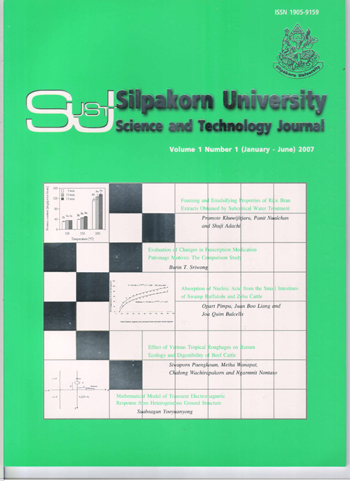Evaluation of Changes in Prescription Medication Patronage Motives: The Comparison Study
Main Article Content
Abstract
The purposes of this study were to: (1) compare the results of selected prescription medication patronage motives to the 1984 study in Madison, Wisconsin, and (2) to compare the top ranked and rated prescription medication patronage criteria for 1999 study. Data were collected in summer 1999. The survey instrument was developed into seven sections, one of which are related to this research. Section one contained 14 prescription medication patronage motive factors. Patronage factors were identified from the literature search from 1970-1997. After pretesting the questionnaire, it was mailed to a systemic random sample of 200 state government employees and 300 households residing in the Madison, Wisconsin area. The response rate was 55.20%. Using the directional student t- test, the results showed that most of the tested prescription medication patronage motive dimensions were significantly different (p < 0.05). Also the test of convergent validity showed that the top five ranked and rated prescription medication patronage dimensions were similar (only in different order). In conclusions, results suggest that overtime pharmacy patrons perceive most of prescription medication patronage motives in more important attitude than 1984 study.
Downloads
Article Details
References
Arneson, D. L., Jacobs, E. W. and Scott, D. M. (1989). Patronage motives of community pharmacy patrons. Journal of Pharmaceutical Marketing and Management, 4(2): 3-22.
Assael, H. (1984.) Consumer Behavior and Marketing Action. Kent Publishing Company., Boston, MA.
Engel, J. F., Kollat. D. T. and Blackwell, R. D. (1992). Consumer Behavior, 4th ed., Dryden Press., Chicago.
Fain, J. M. (1996). Patient perceptions of pharmacist services. Unpublished Doctoral Dissertation. University of Iowa.
Kotler, P. (1988). Marketing Management: Analysis, Planning, Implementation, Control. Prentice-Hall Inc. Englewood Cliffs, NJ
Lusch, R. F. and Darden, W. R. (1981). Retail Patronage Theory. University of Oklahoma Press. Lake Placid, NY.
Melver, J. P. and Carmines, E. G. (1981). Unidimensional Scaling. SAGE Publication. Beverly Hills, CA.
Metge, C. J., Hendricksen, C. and Maine, L. (1998). Consumer attitudes, behaviors, and perceptions about Pharmacies, Pharmacists, and Pharmaceutical Care, 38(1): 37-47.
Nunally, J. C. (1978). Psychometric Theory, 2nd ed. McGraw-Hill Book Company. New York.
Rupp, M. T. and Kreling, D. H. (1994). Whai is known about patient outcomes of pharmaceutical care intervention?: The impact of pharmaceutical careon patient outcomes: What do we know? In patient outcomes of pharmaceutical interventions: A scientific foundation for the future Report. Journal of American Pharmacist Association. Novembe,r 13-15; 54-65.
Schondeleyer, S. W. and Trinca, C. E. (1984). Consumer demand for a pharmacist conducted prescription-counseling services. Journal of American Pharmacist Association, NS23: 65-68.
Smith, H. A. and Coons, S. J. (1990). Patronage factors and consumer satisfaction with source of prescription purchases. Journal of Pharmaceutical Marketing and Management, 4(3): 61-81.
U.S. Bureau of Census (1998). Census of population: Characteristic of the population.
Wiederholt, J. B. (1987). Development of an instrument to measure evaluative criteria that patients use in selecting a pharmacy for obtaining prescription drugs. Journal of Pharmaceutical Marketing and Management, 1: 35-39.


